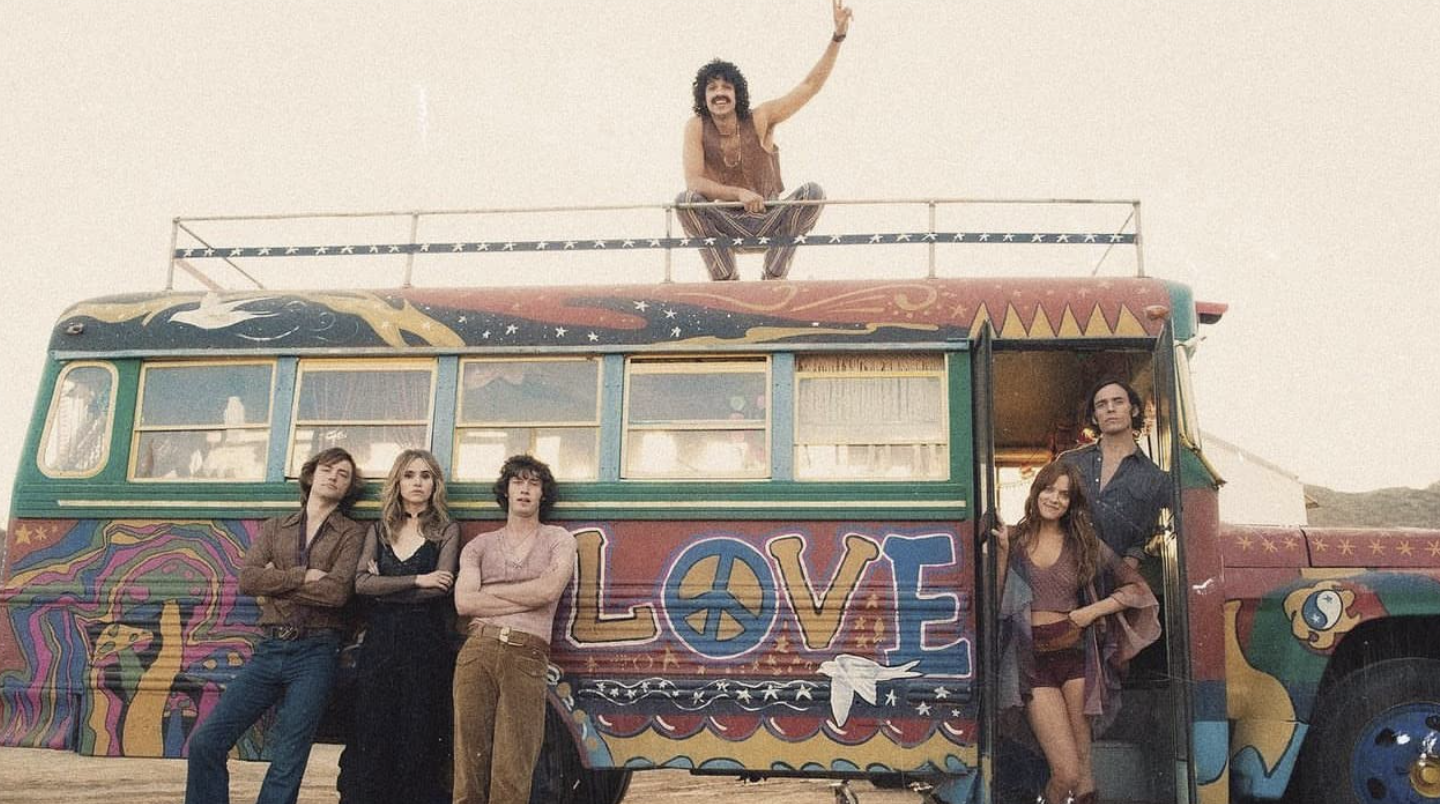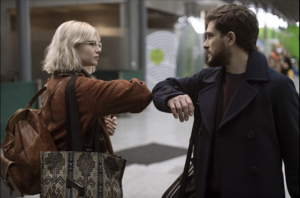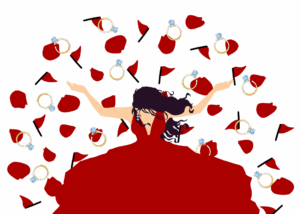It’s 1977. A ragtag band of musicians—fronted by their wavy-haired, waif-life singer-songwriter and suave guitarist—plays to a sold-out stadium of screaming fans. The chemistry between these two lead musicians is palpable. On stage, they’re invincible; behind the curtain, their private lives threaten to tear the group apart at the seams.
So begins the story of Daisy Jones & The Six, the band at the center of the Amazon Prime series of the same name. Although the band is fictional, their narrative is so compelling that it’s easy to forget that this story is a work of fiction. Daisy Jones & The Six is a story about sex, drugs, and rock ‘n’ roll––but it’s also so much more.
Based on Taylor Jenkins Reid’s 2019 novel of the same name, this on-screen adaptation has been highly anticipated. The series follows the origins, rise, and tumultuous fall of a fictional Pittsburgh band, The Six, and their female lead singer, Daisy Jones (Riley Keough). Told in documentary style, the show anchors itself in the 1970s but frames each episode with interview commentary from members of the band, industry executives, and close friends twenty years post-breakup.
Daisy Jones & The Six tackles themes of addiction, fame, and childhood trauma within its depiction of the creative process. Like all bands, Daisy Jones & The Six alternate between crying together and laughing together, cycling through loving each other and hating each other at different points in their journey. However, the most compelling aspect of their story is the intense, confused, mercurial relationship between the lead singer-songwriters, Daisy Jones and Billy Dunne (Sam Claflin). Keough and Claflin’s performances are strong on their own, but their chemistry as a pair is exquisite. Written as twin flames, the dynamic between their characters is both fiery and tender, as they alternate between attracting and repelling each other both in their artistry and their personal lives. With the sensually charged, wordless yet weighted looks passed between them, Claflin and Keough gracefully portray their characters as complicated people cut from the same cloth.
Daisy and Billy are just as vibrant individually. Female rage and desperation for belonging are central to Daisy’s character, but so are stubbornness, ambition, and good intentions—a duality Keough deftly navigates. The first four episodes of the series chart the separate origins of The Six and Daisy Jones, and it is here that Keough demonstrates the balance between Daisy’s lightness in her new creative freedom and her wrath against those who wrong her. In the following six episodes, which chart the band’s collaboration, Keough delivers a nuanced display of hope, loneliness, and stubborn resolve in Daisy that contrasts Claflin’s Billy. Claflin, for his part, expertly plays the role of someone trying to mask his own feelings for Daisy. Viewers are confronted with Billy’s inner conflict—a struggle to separate his passion for songwriting from the passion he feels for his co-writer. Both Keough and Claflin walk the fine line between subtle acting and volatile displays of emotion. When Billy finds himself frozen in fear, unable to pick up his infant daughter, for instance, it is Claflin’s abrupt tears that make the scene so poignant.
Though riveting, the focus on Daisy and Billy leaves some characters sidelined, especially towards the back half of the series. This is the fate that befalls Camila (Camila Morrone), Billy’s wife. Once the focus shifts to Daisy and Billy’s dynamic, Camila—once a pillar of strength for both The Six and her family in times of distress—is largely diminished to sidelong, suspicious glances, reducing her character to little more than a jealous wife. In contrast to her more robust literary counterpart, the Camila we see onscreen is constrained to the bitter wife archetype in the latter half of the series.
Another character whose arc falls flat compared to the rest of the cast is happy-go-lucky drummer Warren Rojas (Sebastian Chacone). While Warren adds a fun-loving, humorous flair in contrast to his more moody, melodramatic band mates (looking at you, Billy and Eddie (Josh Whitehouse)), his character never really evolves past that of the comedic relief.
The show is a love letter to the Los Angeles of the 1970s: the cinematography, set design, and costuming beautifully pay homage to the decade of rock ‘n’ roll. The interview scenes carry a grainy, yellow tint, reminiscent of something shot on film, and the flashbacks’ color grading emulates an authentically vintage feel. Like the HBO hit Euphoria, which helped usher in the renaissance of Y2k fashion, Daisy Jones is reviving the 70s boho-Western aesthetic of bell bottoms, fringe, crochet, and tanned leather.
Given that the show revolves around an iconic 70s rock band, it wouldn’t be complete without releasing a full-length accompanying album. Titled Aurora, the eleven-track record is available to stream on all music platforms. While the track list is drastically different from the songs described in the novel, with music this spectacular, it is difficult to criticize the changes. And yes, that really is Keough and Claflin singing.
Amidst an album of standouts, “The River” rises to the top of the heap. Once the first electric guitar strum strikes down on the tambourine beat like a bolt of lightning, the rest of the track roars to life in a stunning display of grit and passion. After a few rounds of the supremely catchy chorus, Keough’s belts wail across the bridge like the screams of a scorned siren, cracking with agony and heartbreak. Her vocal performance is truly breathtaking here; while this titular river may be roaring, so is Keough, a fire-maned lioness in full-command. The song captures both the time-period-specific contours of seventies rock and the passionate feelings between Billy and Daisy that guide the show’s narrative.
While “The River” is perhaps the most riveting song featured on screen, track 5, “Look At Us Now (Honeycomb),” is the bleeding heart of both Aurora and the show alike. Though admittedly repetitive, this brooding ballad encompasses Billy and Daisy’s internal and interpersonal frustrations. Complete with aching guitars and vocals alike, the soulful melody harbors layers of turmoil.
“Look at Us Now (Honeycomb)” features a guitar solo reminiscent of Fleetwood Mac’s “The Chain”––a fitting inclusion considering that the iconic British-American rock band is a primary source of inspiration for both the music and the story of Daisy Jones & The Six. The infamous interpersonal drama and the affair between Stevie Nicks and Lindsey Buckingham that came to a head at the live performance of “Silver Springs” in 1997 laid the blueprint for the climactic final performance of Daisy Jones & The Six in the show. Like Fleetwood Mac’s Rumours (1977), all of the songs for Aurora were recorded at the studio Sound City which also features as a prominent set location within the show. With her long curly hair and bangs, Keough’s Daisy Jones even looks like iconic singer-songwriter Nicks, bell-sleeved dresses and all.
The growth of Daisy Jones & the Six from book to miniseries and accompanying album creates a dimension of realism that pushes the boundaries of traditional page-to-screen adaptations. The series, already strengthened by dynamic performances, attentive set and costume design, and well-paced writing, powerfully evokes the memory of 1970s rock ‘n’ roll in L.A. through its musical production and visual styling. With a teased tour in the works, this fictional band is poised to leap off the page and screen and into the real world––bringing the bygone feel and style of the 1970s to life with it.
Read on for our discussion of the book-to-television adaptation––Taylor Jenkins Reid-style.
How familiar were you with Reid’s book, prior to watching the show?
HAILEY: I immediately fell in love with Daisy Jones & The Six as soon as I read it. As a singer-songwriter, reading a book in which the main characters also find solace in channeling their emotions into the music they write was an absolute delight.
NIKKI: It’s one of those books that hasn’t left my mind since I put it down. I remember feeling taken aback by how attached I became to the narrative despite its departure from traditional storytelling.
AMANDA: So I’m a bit of a black sheep here…I picked up the book last summer and put it down at page 30. I just couldn’t get behind the interview transcript style writing. I like that with traditional narratives you can get a fuller sense of the world they’re living in and you can get inside the characters’ heads. I didn’t get that with Daisy Jones.
N: That’s so fair. I had never read something in the style of an oral history, so I also went in skeptical. But I think Reid tells a vivid story of failed relationships, drug addictions, and severe insecurities, balanced brilliantly with themes of creative identity, unwavering love, and hope. It felt genius to me, even though I knew its writing style wouldn’t work for everyone.
A: Yeah, other people told me they listened to the book as an audiobook, which I think makes more sense. An audiobook would make it feel more like listening to a podcast, where you have different voice actors playing different roles in the story.
H: Personally, I found the dialogue-dependent format on the page really engaging and brilliantly suited to telling this documentary story to its fullest capacity. But for those who didn’t have that same positive experience, I really do think the audiobook is a fantastic option! I’ve been re-reading with the audiobook recently and it’s been lovely.
N: I think the characters were ultimately my favorite element of the story. Daisy and Billy’s relationship was just electric, and Reid’s commitment to fleshing out Camila’s narrative was something I found central to the novel’s ingenuity. And when you also recognize the robust characters of Simone and Karen, it becomes clear that this book is spearheaded by striking female characters.
H: I also really enjoyed how much this story reminded me of my favorite film—La La Land (2016). Both stories masterfully explore the nature of creative artistry and the bittersweetness that comes with loving someone who might not necessarily be right for you in that particular moment in time. Needless to say, Daisy Jones & The Six skyrocketed to near the top of my favorite books list as soon as I turned the final page.
With most book-to-screen adaptations, a lot of detail gets cut or significantly altered for efficiency. For those who read the book, what changes did you notice most?
H: Though I liked many of the changes, Camila’s characterization in the show left a bad taste in my mouth. Morrone’s screen adaptation of Camila is soft around the edges when compared to her literary counterpart. While book Camila is confident that her relationship with Billy is stronger than any obstacle, the Camila we see on screen is more easily moved to tearful dismay over her husband’s emotional infidelity.
N: Camila’s character caught me the most off-guard, too. The novel largely avoided incorporating jealousy into her development, whereas the show hinted at the swift relationship between Eddie and Camila as retaliation against Billy’s infidelity. I didn’t mind seeing that side of Camila, per se—it was honestly warranted—but it did create a character less courageous and strong-willed than the one I met last March.
H: While series Camila’s response to Billy’s feelings for Daisy is perhaps a more realistic, conventional response, the idiosyncratic nature of book Camila’s steadfast resolve to make her relationship with Billy go the distance was exactly why I fell in love with her character. The end of the show also culminated in a complete restructuring of a pivotal scene between Camila and Daisy. In the book, their final conversation is a moment of incredible strength for both women—a chance for each of them to demonstrate their love for Billy by working together to do what is ultimately best for him. On the other hand, this new ending is far more conflictual and removes much of Camila’s agency. I much prefer how Reid managed to invest readers in the Daisy and Billy relationship without ever cheapening Camila’s character by reducing her to “the other woman” or nothing more than a frustrating barrier to the leads’ anticipated union.
N: The other major discrepancy was the physical side of Daisy and Billy’s relationship. That, to me, was a drastic change. When I read the book, I interpreted the relationship between the two as never having become physical, always flickering in the space between them; the television series upended this for me entirely. It didn’t take long for me to get onboard with it, but the idea of Daisy and Billy never kissing made them much more enigmatic in the novel.
Did the album, Aurora, leave as much of an impression as the series?
H: Oh, absolutely. I am a huge Fleetwood Mac fan, so everything about Aurora is right up my alley. As soon as I finished reading Daisy Jones & The Six, I remember feeling so disappointed I couldn’t listen to Aurora for myself, so I am just delighted that this album ended up surpassing all of my expectations!
A: I’ve been listening to the album for weeks, pretty much since the first three episodes dropped. I love the 70s rock feel of the album and I think it pairs pretty neatly with the series––every time I listen to “More Fun to Miss,” I picture that scene in episode 6, with Daisy in the recording booth making prolonged eye contact with Billy after their kiss.
N: Oh, man. That SCENE. I was watching on a plane and did not react even remotely calmly.
H: Genuinely cannot even count how many times I pressed the rewind button…
N: It’s interesting, because that didn’t happen in the book by any means; the kiss was only ever alluded to. So now you have this moment between Daisy and Billy immortalized in a song as snarky and ragged as “More Fun to Miss,” and that context makes all the difference. Really, every track corresponds to a scene in the series. “Let Me Down Easy” and “Kill You To Try” will forever make me think of Daisy and Billy in their songwriting phase, and “The River” continues to be an absolute powerhouse.
H: Agreed! I can’t wait to blast those songs while driving around my hometown with my windows rolled down this summer.
There are rumors that the cast of Daisy Jones & The Six is preparing for a tour. What are your thoughts on this fictional band becoming reality?
N: [laughs] I told my friend about this and she thought it would muddy the line between fiction and reality too much. Personally, I am so willing to muddy that line. Give me Daisy Jones & The Six. They’re practically my favorite band as it is.
H: Say the word and I’m there—bell bottoms, crochet top, heart-shaped sunglasses, the whole nine yards.
A: Yeah, I’m there. Take my money.





